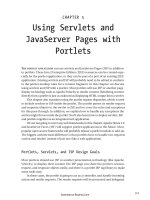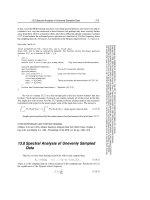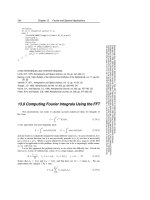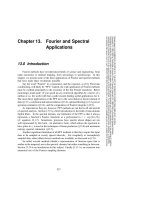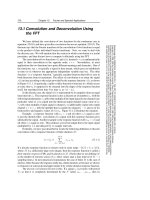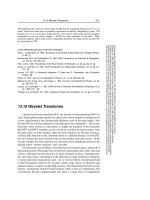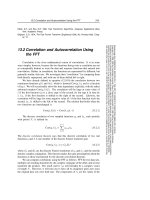core servlets and sp
Bạn đang xem bản rút gọn của tài liệu. Xem và tải ngay bản đầy đủ của tài liệu tại đây (9.6 MB, 617 trang )
Overview of On-Line Version
We hope you enjoy this PDF version of the first edition of the international bestseller
Core Servlets and JavaServer Pages (courtesy of Sun Microsystems Press). If you are
interested in the second edition of the book, it is available through most major on-line
and brick-and-mortar bookstores. See
for details.
Interested in the sequel? Check out More Servlets and JavaServer Pages at
.
Looking for servlet and JSP short courses
taught by the author? Visit
.
Available on-site at your company
or at public venues.
v
Chapter
© Prentice Hall and Sun Microsystems. Personal use only; do not redistribute.
Second edition of this book: .
Sequel: .
Servlet and JSP training courses: .
Acknowledgments xix
About the Author xx
Introduction xxi
Real Code for Real Programmers xxii
How This Book Is Organized xxiii
Conventions xxvii
About the Web Site xxvii
Part 1
Servlets 2.1 and 2.2 2
Chapter 1
Overview of Servlets and JavaServer Pages 4
1.1 Servlets 5
1.2 The Advantages of Servlets Over “Traditional” CGI 7
Efficient 7
Convenient 7
Table of Contents
vi Contents
© Prentice Hall and Sun Microsystems. Personal use only; do not redistribute.
Powerful 8
Portable 8
Secure 8
Inexpensive 9
1.3 JavaServer Pages 9
1.4 The Advantages of JSP 10
Versus Active Server Pages (ASP) 10
Versus PHP 10
Versus Pure Servlets 11
Versus Server-Side Includes (SSI) 11
Versus JavaScript 11
Versus Static HTML 12
1.5 Installation and Setup 12
Obtain Servlet and JSP Software 12
Bookmark or Install the Servlet and JSP API Documentation 14
Identify the Classes to the Java Compiler 14
Package the Classes 15
Configure the Server 16
Start the Server 17
Compile and Install Your Servlets 18
Chapter 2
First Servlets 20
2.1 Basic Servlet Structure 21
2.2 A Simple Servlet Generating Plain Text 23
Compiling and Installing the Servlet 24
Invoking the Servlet 25
2.3 A Servlet That Generates HTML 26
2.4 Packaging Servlets 27
Creating Servlets in Packages 28
Compiling Servlets in Packages 29
Invoking Servlets in Packages 30
2.5 Simple HTML-Building Utilities 31
2.6 The Servlet Life Cycle 34
The init Method 34
The service Method 36
Contents vii
© Prentice Hall and Sun Microsystems. Personal use only; do not redistribute.
The doGet, doPost, and doXxx Methods 37
The SingleThreadModel Interface 38
The destroy Method 38
2.7 An Example Using Initialization Parameters 39
2.8 An Example Using Servlet Initialization and Page Modification Dates 44
2.9 Debugging Servlets 50
2.10 WebClient: Talking to Web Servers Interactively 52
WebClient 52
HttpClient 55
NetworkClient 57
SocketUtil 59
CloseableFrame 60
LabeledTextField 61
Interruptible 63
Chapter 3
Handling the Client Request: Form Data 64
3.1 The Role of Form Data 65
3.2 Reading Form Data from Servlets 66
3.3 Example: Reading Three Explicit Parameters 67
3.4 Example: Reading All Parameters 70
3.5 A Resumé Posting Service 74
3.6 Filtering Strings for HTML-Specific Characters 87
Code for Filtering 88
Example 89
Chapter 4
Handling the Client Request: HTTP Request Headers 92
4.1 Reading Request Headers from Servlets 94
4.2 Printing All Headers 96
4.3 HTTP 1.1 Request Headers 98
4.4 Sending Compressed Web Pages 104
4.5 Restricting Access to Web Pages 107
viii Contents
© Prentice Hall and Sun Microsystems. Personal use only; do not redistribute.
Chapter 5
Accessing the Standard CGI Variables 114
5.1 Servlet Equivalent of CGI Variables 116
5.2 A Servlet That Shows the CGI Variables 119
Chapter 6
Generating the Server Response: HTTP Status Codes 122
6.1 Specifying Status Codes 124
6.2 HTTP 1.1 Status Codes and Their Purpose 126
6.3 A Front End to Various Search Engines 135
Chapter 7
Generating the Server Response: HTTP Response Headers 142
7.1 Setting Response Headers from Servlets 143
7.2 HTTP 1.1 Response Headers and Their Meaning 145
7.3 Persistent Servlet State and Auto-Reloading Pages 154
7.4 Using Persistent HTTP Connections 163
7.5 Using Servlets to Generate GIF Images 168
Chapter 8
Handling Cookies 178
8.1 Benefits of Cookies 179
Identifying a User During an E-commerce Session 180
Avoiding Username and Password 180
Customizing a Site 180
Focusing Advertising 181
8.2 Some Problems with Cookies 181
8.3 The Servlet Cookie API 183
Creating Cookies 183
Cookie Attributes 183
Placing Cookies in the Response Headers 186
Reading Cookies from the Client 186
8.4 Examples of Setting and Reading Cookies 186
Contents ix
© Prentice Hall and Sun Microsystems. Personal use only; do not redistribute.
8.5 Basic Cookie Utilities 190
Finding Cookies with Specified Names 190
Creating Long-Lived Cookies 191
8.6 A Customized Search Engine Interface 191
Chapter 9
Session Tracking 198
9.1 The Need for Session Tracking 199
Cookies 200
URL-Rewriting 200
Hidden Form Fields 201
Session Tracking in Servlets 201
9.2 The Session Tracking API 201
Looking Up the HttpSession Object Associated with the Current
Request
202
Looking Up Information Associated with a Session 202
Associating Information with a Session 205
Terminating Sessions 206
Encoding URLs Sent to the Client 206
9.3 A Servlet Showing Per-Client Access Counts 207
9.4 An On-Line Store Using a Shopping Cart and Session Tracking 209
Building the Front End 210
Handling the Orders 215
Behind the Scenes: Implementing the Shopping Cart and
Catalog Items
220
Part 2
JavaServer Pages 228
Chapter 10
JSP Scripting Elements 230
10.1 Scripting Elements 233
Template Text 234
10.2 JSP Expressions 234
xContents
© Prentice Hall and Sun Microsystems. Personal use only; do not redistribute.
Predefined Variables 234
XML Syntax for Expressions 235
Using Expressions as Attribute Values 235
Example 236
10.3 JSP Scriptlets 238
Using Scriptlets to Make Parts of the JSP File Conditional 241
Special Scriptlet Syntax 242
10.4 JSP Declarations 242
Special Declaration Syntax 244
10.5 Predefined Variables 244
Chapter 11
The JSP page Directive: Structuring Generated Servlets 246
11.1 The import Attribute 248
Directories for Custom Classes 248
Example 249
11.2 The contentType Attribute 251
Generating Plain Text Documents 252
Generating Excel Spreadsheets 254
11.3 The isThreadSafe Attribute 258
11.4 The session Attribute 259
11.5 The buffer Attribute 259
11.6 The autoflush Attribute 260
11.7 The extends Attribute 260
11.8 The info Attribute 260
11.9 The errorPage Attribute 261
11.10 The isErrorPage Attribute 261
11.11 The language Attribute 264
11.12 XML Syntax for Directives 265
Chapter 12
Including Files and Applets in JSP Documents 266
12.1 Including Files at Page Translation Time 268
12.2 Including Files at Request Time 270
Contents xi
© Prentice Hall and Sun Microsystems. Personal use only; do not redistribute.
12.3 Including Applets for the Java Plug-In 274
The jsp:plugin Element 275
The jsp:param and jsp:params Elements 277
The jsp:fallback Element 278
Example: Building Shadowed Text 279
Chapter 13
Using JavaBeans with JSP 286
13.1 Basic Bean Use 288
Accessing Bean Properties 290
Setting Bean Properties: Simple Case 290
Installing Bean Classes 291
13.2 Example: StringBean 292
13.3 Setting Bean Properties 294
Associating Individual Properties with Input Parameters 298
Automatic Type Conversions 300
Associating All Properties with Input Parameters 301
13.4 Sharing Beans 302
Conditional Bean Creation 304
Chapter 14
Creating Custom JSP Tag Libraries 308
14.1 The Components That Make Up a Tag Library 310
The Tag Handler Class 310
The Tag Library Descriptor File 311
The JSP File 313
14.2 Defining a Basic Tag 314
The Tag Handler Class 315
The Tag Library Descriptor File 316
The JSP File 318
14.3 Assigning Attributes to Tags 319
The Tag Handler Class 319
The Tag Library Descriptor File 321
The JSP File 322
14.4 Including the Tag Body 323
xii Contents
© Prentice Hall and Sun Microsystems. Personal use only; do not redistribute.
The Tag Handler Class 324
The Tag Library Descriptor File 326
The JSP File 328
14.5 Optionally Including the Tag Body 329
The Tag Handler Class 329
The Tag Library Descriptor File 331
The JSP File 332
14.6 Manipulating the Tag Body 334
The Tag Handler Class 334
The Tag Library Descriptor File 335
The JSP File 336
14.7 Including or Manipulating the Tag Body Multiple Times 338
The Tag Handler Class 338
The Tag Library Descriptor File 340
The JSP File 341
14.8 Using Nested Tags 341
The Tag Handler Classes 342
The Tag Library Descriptor File 348
The JSP File 350
Chapter 15
Integrating Servlets and JSP 352
15.1 Forwarding Requests 354
Using Static Resources 354
Supplying Information to the Destination Pages 355
Interpreting Relative URLs in the Destination Page 357
Alternative Means of Getting a RequestDispatcher 358
15.2 Example: An On-Line Travel Agent 358
15.3 Including Static or Dynamic Content 375
15.4 Example: Showing Raw Servlet and JSP Output 377
15.5 Forwarding Requests From JSP Pages 380
Contents xiii
© Prentice Hall and Sun Microsystems. Personal use only; do not redistribute.
Part 3
Supporting Technologies 382
Chapter 16
Using HTML Forms 384
16.1 How HTML Forms Transmit Data 385
16.2 The FORM Element 390
16.3 Text Controls 395
Textfields 395
Password Fields 397
Text Areas 398
16.4 Push Buttons 400
Submit Buttons 401
Reset Buttons 404
JavaScript Buttons 405
16.5 Check Boxes and Radio Buttons 405
Check Boxes 406
Radio Buttons 407
16.6 Combo Boxes and List Boxes 409
16.7 File Upload Controls 412
16.8 Server-Side Image Maps 414
IMAGE—Standard Server-Side Image Maps 414
ISMAP—Alternative Server-Side Image Maps 417
16.9 Hidden Fields 419
16.10 Grouping Controls 420
16.11 Controlling Tab Order 422
16.12 A Debugging Web Server 423
EchoServer 423
ThreadedEchoServer 427
NetworkServer 428
Chapter 17
Using Applets As Servlet Front Ends 432
17.1 Sending Data with GET and Displaying the Resultant Page 434
xiv Contents
© Prentice Hall and Sun Microsystems. Personal use only; do not redistribute.
17.2 A Multisystem Search Engine Front End 435
17.3 Sending Data with GET and Processing the Results Directly
(HTTP Tunneling)
438
Reading Binary or ASCII Data 439
Reading Serialized Data Structures 441
17.4 A Query Viewer That Uses Object Serialization and HTTP
Tunneling
443
17.5 Sending Data by POST and Processing the Results Directly
(HTTP Tunneling)
450
17.6 An Applet That Sends POST Data 453
17.7 Bypassing the HTTP Server 459
Chapter 18
JDBC and Database Connection Pooling 460
18.1 Basic Steps in Using JDBC 462
Load the Driver 462
Define the Connection URL 463
Establish the Connection 464
Create a Statement 465
Execute a Query 465
Process the Results 465
Close the Connection 466
18.2 Basic JDBC Example 467
18.3 Some JDBC Utilities 473
18.4 Applying the Database Utilities 482
18.5 An Interactive Query Viewer 487
Query Viewer Code 489
18.6 Prepared Statements (Precompiled Queries) 497
18.7 Connection Pooling 501
18.8 Connection Pooling: A Case Study 508
18.9 Sharing Connection Pools 515
Using the Servlet Context to Share Connection Pools 515
Using Singleton Classes to Share Connection Pools 516
Contents xv
© Prentice Hall and Sun Microsystems. Personal use only; do not redistribute.
Appendix
Servlet and JSP Quick Reference 518
A.1 Overview of Servlets and JavaServer Pages 519
Advantages of Servlets 519
Advantages of JSP 519
Free Servlet and JSP Software 519
Documentation 520
Servlet Compilation: CLASSPATH Entries 520
Tomcat 3.0 Standard Directories 520
Tomcat 3.1 Standard Directories 520
JSWDK 1.0.1 Standard Directories 520
Java Web Server 2.0 Standard Directories 521
A.2 First Servlets 521
Simple Servlet 521
Installing Servlets 521
Invoking Servlets 521
Servlet Life Cycle 522
A.3 Handling the Client Request: Form Data 523
Reading Parameters 523
Example Servlet 523
Example Form 524
Filtering HTML-Specific Characters 524
A.4 Handling the Client Request: HTTP Request Headers 524
Methods That Read Request Headers 524
Other Request Information 525
Common HTTP 1.1 Request Headers 525
A.5 Accessing the Standard CGI Variables 526
Capabilities Not Discussed Elsewhere 526
Servlet Equivalent of CGI Variables 526
A.6 Generating the Server Response: HTTP Status Codes 527
Format of an HTTP Response 527
Methods That Set Status Codes 527
Status Code Categories 527
Common HTTP 1.1 Status Codes 527
A.7 Generating the Server Response: HTTP Response Headers 528
Setting Arbitrary Headers 528
xvi Contents
© Prentice Hall and Sun Microsystems. Personal use only; do not redistribute.
Setting Common Headers 528
Common HTTP 1.1 Response Headers 528
Generating GIF Images from Servlets 529
A.8 Handling Cookies 530
Typical Uses of Cookies 530
Problems with Cookies 530
General Usage 530
Cookie Methods 530
A.9 Session Tracking 531
Looking Up Session Information: getValue 531
Associating Information with a Session: putValue 531
HttpSession Methods 532
Encoding URLs 533
A.10 JSP Scripting Elements 533
Types of Scripting Elements 533
Template Text 533
Predefined Variables 533
A.11 The JSP page Directive: Structuring Generated Servlets 534
The import Attribute 534
The contentType Attribute 534
Example of Using contentType 534
Example of Using setContentType 535
The isThreadSafe Attribute 535
The session Attribute 536
The buffer Attribute 536
The autoflush Attribute 536
The extends Attribute 536
The info Attribute 536
The errorPage Attribute 536
The isErrorPage Attribute 536
The language Attribute 536
XML Syntax 537
A.12 Including Files and Applets in JSP Documents 537
Including Files at Page Translation Time 537
Including Files at Request Time 537
Applets for the Java Plug-In: Simple Case 537
Attributes of jsp:plugin 537
Contents xvii
© Prentice Hall and Sun Microsystems. Personal use only; do not redistribute.
Parameters in HTML: jsp:param 538
Alternative Text 538
A.13 Using JavaBeans with JSP 539
Basic Requirements for Class to be a Bean 539
Basic Bean Use 539
Associating Properties with Request Parameters 539
Sharing Beans: The scope Attribute of jsp:useBean 539
Conditional Bean Creation 540
A.14 Creating Custom JSP Tag Libraries 540
The Tag Handler Class 540
The Tag Library Descriptor File 541
The JSP File 541
Assigning Attributes to Tags 541
Including the Tag Body 541
Optionally Including the Tag Body 542
Manipulating the Tag Body 542
Including or Manipulating the Tag Body Multiple Times 542
Using Nested Tags 542
A.15 Integrating Servlets and JSP 542
Big Picture 542
Request Forwarding Syntax 543
Forwarding to Regular HTML Pages 543
Setting Up Globally Shared Beans 543
Setting Up Session Beans 543
Interpreting Relative URLs in the Destination Page 543
Getting a RequestDispatcher by Alternative Means (2.2 Only) 543
Including Static or Dynamic Content 544
Forwarding Requests from JSP Pages 544
A.16 Using HTML Forms 544
The FORM Element 544
Textfields 544
Password Fields 544
Text Areas 545
Submit Buttons 545
Alternative Push Buttons 545
Reset Buttons 545
Alternative Reset Buttons 545
xviii Contents
© Prentice Hall and Sun Microsystems. Personal use only; do not redistribute.
JavaScript Buttons 546
Alternative JavaScript Buttons 546
Check Boxes 546
Radio Buttons 546
Combo Boxes 546
File Upload Controls 547
Server-Side Image Maps 547
Hidden Fields 547
Internet Explorer Features 547
A.17 Using Applets As Servlet Front Ends 547
Sending Data with GET and Displaying the Resultant Page 547
Sending Data with GET and Processing the Results Directly
(HTTP Tunneling)
548
Sending Serialized Data: The Applet Code 549
Sending Serialized Data: The Servlet Code 549
Sending Data by POST and Processing the Results Directly
(HTTP Tunneling)
550
Bypassing the HTTP Server 551
A.18 JDBC and Database Connection Pooling 552
Basic Steps in Using JDBC 552
Database Utilities 553
Prepared Statements (Precompiled Queries) 553
Steps in Implementing Connection Pooling 554
Index 557
xix
Chapter
Many people have helped me out with this book. Without their assistance, I
would still be on the third chapter. John Guthrie, Amy Karlson, Rich Slywc-
zak, and Kim Topley provided valuable technical feedback on virtually every
chapter. Others pointing out errors and providing useful suggestions include
Don Aldridge, Camille Bell, Ben Benokraitis, Larry Brown, Carl Burnham,
Andrew Burton, Rick Cannon, Kevin Cropper, Chip Downs, Frank Erickson,
Payam Fard, Daniel Goldman, Rob Gordon, Andy Gravatt, Jeff Hall, Russell
Holley, David Hopkins, Lis Immer, Herman Ip, Truong Le, Frank Lewis,
Tanner Lovelace, Margaret Lyell, Paul McNamee, Mike Oliver, Barb Ride-
nour, Himanso Sahni, Bob Samson, Ron Tosh, Tsung-Wen Tsai, Peggy Sue
Vickers, and Maureen Knox Yencha. Hopefully I learned from their advice.
Mary Lou “Eagle Eye” Nohr spotted my errant commas, awkward sentences,
typographical errors, and grammatical inconsistencies. She improved the
result immensely. Joanne Anzalone produced the final version; she did a
great job despite my many last-minute changes. Ralph Semmel provided a
supportive work environment and a flexible schedule, not to mention inter-
esting projects on which to put servlets and JSP to work. Greg Doench of
Prentice Hall believed in the concept from the beginning and encouraged me
to write the book. Rachel Borden got Sun Microsystems Press to believe in it
also. Thanks to all.
Most of all, thanks to B.J., Lindsay, and Nathan for their patience with my
funny schedule and my hogging the computer when they wanted to work or
play on it. God has blessed me with a great family.
xx About the Author
About the Author
Marty Hall is a Senior Computer Sci-
entist in the Research and Technology
Development Center at the Johns
Hopkins University Applied Physics
Lab, where he specializes in applica-
tions of Java and Web technology. He
also teaches Java and Web program-
ming in the Johns Hopkins part-time
graduate program in Computer Sci-
ence, where he directs the Distributed
Computing and Web Technology con-
centration areas. When he gets a chance, he also teaches industry short
courses on servlets, JavaServer Pages, and other Java technology areas.
Marty’s previous book is Core Web Programming (Prentice Hall, 1998). He
can be reached at the following address:
Research and Technology Development Center
The Johns Hopkins University Applied Physics Laboratory
11100 Johns Hopkins Road
Laurel, MD 20723
xxi
Chapter
n early 1996, I started using the Java programming language for the
majority of my software development work. I did some CGI program-
ming and even worked a little with the early servlet versions, but for the
most part I did desktop and client-side applications. Over the last couple of
years, however, there has been a growing emphasis on server-side applications,
so I became more serious about servlets and JavaServer Pages. In the past year,
there has been a virtual stampede toward the technology among developers,
server vendors, and the authors of the Java platform specifications. So much so,
in fact, that the technology is rapidly becoming the standard tool for building
dynamic Web sites and connecting Web front ends to databases and applica-
tions on a server.
Unfortunately, however, it was extremely difficult to find good practical
advice on servlet and JSP development. I found a number of servlet books, but
only a handful of them covered recent versions of the specification, advanced
techniques, or reflected real-world experience. The few that did, if they cov-
ered JSP at all, hadn’t caught up to JSP 1.0, let alone JSP 1.1. Since JSP is a bet-
ter fit than servlets for many situations, what good was a servlet book that didn’t
also cover JSP? In the last couple of months, some JSP books have started com-
ing out. But the bulk of them don’t cover servlets. What good is that? Since an
integral part of JavaServer Pages is the use of scripting elements to create serv-
let code, you can’t do effective JSP development without a thorough under-
standing of servlets. Besides, most real-world sites don’t use just one of the two
I
xxii Introduction
technologies; they combine them both. Finally, as I discovered when I started
teaching servlet and JSP development to my students in the Johns Hopkins
part-time graduate program (most of whom were professional software devel-
opers), few programmers were already comfortable with HTTP 1.1, HTML
forms, and JDBC, three critical supporting technologies. Telling them to get a
separate book for each of these areas was hardly reasonable: that brought to
five the number of books programmers needed if they were going to do serious
servlet/JSP development.
So, in mid-1999, I put together a short servlet and JSP tutorial with a few
dozen examples, put it on the Web, and tried out the material in a couple of
my courses. The response was overwhelming. After only a few months, I
was getting several thousand visitors a day to the tutorial along with a myr-
iad of requests to expand the coverage of the material. I eventually bowed
to the inevitable and started writing. This book is the result. I hope you find
it useful.
Real Code for Real Programmers
This book is aimed at serious software developers. This is not a book that
touts the potential of e-commerce or pontificates about how Web-enabled
applications will revolutionize your business. Instead, it is a hands-on book
aimed at helping programmers who are already convinced of the need for
dynamic Web sites get started building them right away. In showing how to
build these sites, I try to illustrate the most important approaches and warn
you of the most common pitfalls. Along the way, I include plenty of working
code: more than a hundred documented Java classes, for instance. I try to
give detailed examples of the most important and frequently used features,
summarize the lesser-used ones, and refer you to the APIs (available
on-line) for a few of the rarely used ones.
Nor is this a book that skims dozens of technologies at a high level.
Although I don’t claim that this is a definitive reference on every technology
it touches on (e.g., there are a number of books this size just on JDBC), if the
book covers a topic, it does so in enough detail for you to sit down and start
writing real programs. The one exception to this rule is the Java programming
language itself. Although I don’t assume any familiarity with server-side pro-
gramming, I do expect you to be familiar with the basics of Java language
development. If you’re not, you will need to pick up a good tutorial like Core
Java, Core Web Programming, or Thinking in Java.
How This Book Is Organized xxiii
A word of caution, however. Nobody becomes a great developer just by
reading. You have to write some real code, too. The more, the better. In each
chapter, I suggest that you start by making a simple program or a small varia-
tion of one of the examples given, then strike off on your own with a more sig-
nificant project. Skim the sections you don’t plan on using right away, then
come back when you are ready to try them out.
If you do this, you should quickly develop the confidence to handle the
real-world problems that brought you here in the first place. You should be
able to decide where servlets apply well, where JSP is better, and where a com-
bination is best. You should not only know how to generate HTML content, but
you should also understand building other media types like GIF images or
Excel spreadsheets. You should understand HTTP 1.1 well enough to use its
capabilities to enhance the effectiveness of your pages. You should have no
qualms about developing Web interfaces to your corporate databases, using
either HTML forms or applets as front ends. You should be able to spin off
complex behaviors into JavaBeans components or custom JSP tag libraries,
then decide when to use these components directly and when to start requests
with servlets that set things up for separate presentation pages. You should have
fun along the way. You should get a raise.
How This Book Is Organized
This book is divided into three parts: Servlets, JavaServer Pages, and Sup-
porting Technologies.
Part I: Servlets
Part I covers servlet development with the 2.1 and 2.2 specifications.
Although version 2.2 (along with JSP 1.1) is mandated by the Java 2
Platform, Enterprise Edition (J2EE), many commercial products are
still at the earlier releases, so it is important to understand the differ-
ences. Also, although servlet code is portable across a huge variety of
servers and operating systems, server setup and configuration details
are not standardized. So, I include specific details for Apache Tomcat,
Sun’s JavaServer Web Development Kit (JSWDK), and the Java Web
Server. Servlet topics include:
• When and why you would use servlets
• Obtaining and configuring the servlet and JSP software
xxiv Introduction
• The basic structure of servlets
• The process of compiling, installing, and invoking servlets
• Generating HTML from servlets
• The servlet life cycle
• Page modification dates and browser caches
• Servlet debugging strategies
• Reading form data from servlets
• Handling both
GET and POST requests with a single servlet
• An on-line resume posting service
• Reading HTTP request headers from servlets
• The purpose of each of the HTTP 1.1 request headers
• Reducing download times by compressing pages
• Restricting access with password-protected servlets
• The servlet equivalent of each standard CGI variable
• Using HTTP status codes
• The meaning of each of the HTTP 1.1 status code values
• A search engine front end
• Setting response headers from servlets
• The purpose of each of the HTTP 1.1 response headers
• Common MIME types
• A servlet that uses the Refresh header to repeatedly access
ongoing computations
• Servlets that exploit persistent (keep-alive) HTTP connections
• Generating GIF images from servlets
• Cookie purposes and problems
• The Cookie API
• Some utilities that simplify cookie handling
• A customized search engine front end
• The purposes of session tracking
• The servlet session tracking API
• Using sessions to show per-client access counts
• An on-line store that uses session tracking, shopping carts, and
pages automatically built from catalog entries
How This Book Is Organized xxv
Part II: JavaServer Pages
JSP provides a convenient alternative to servlets for pages that mostly
consist of fixed content. Part II covers the use of JavaServer Pages ver-
sion 1.0 and 1.1. JSP topics include:
• When and why you would use JavaServer Pages
• How JSP pages are invoked
• Using JSP expressions, scriptlets, and declarations
• Predefined variables that can be used within expressions and
scriptlets
• The
page directive
• Designating which classes are imported
• Specifying the MIME type of the page
• Generating Excel spreadsheets
• Controlling threading behavior
• Participating in sessions
• Setting the size and behavior of the output buffer
• Designating pages to process JSP errors
• XML-compatible syntax for directives
• Including JSP files at the time the main page is translated into a
servlet
• Including HTML or plain text files at the time the client
requests the page
• Including applets that use the Java Plug-In
• Using JavaBeans with JSP
• Creating and accessing beans
• Setting bean properties explicitly
• Associating bean properties with input parameters
• Automatic conversion of bean property types
• Sharing beans among multiple JSP pages and servlets
• Creating JSP tag libraries
• Tag handler classes
• Tag library descriptor files
• The JSP
taglib directive
• Simple tags
• Tags that use attributes
• Tags that use the body content between their start and end tags
• Tags that modify their body content
• Looping tags
• Nested tags
xxvi Introduction
• Integrating servlets and JSP
• Forwarding requests from servlets to static and dynamic
resources
• Using servlets to set up beans for use by JSP pages
• An on-line travel agency combining servlets and JSP
• Including JSP output in servlets
• Forwarding requests from JSP pages
Part III: Supporting Technologies
Part III covers three topics that are commonly used in conjunction
with servlets and JSP: HTML forms, applets talking to servlets, and
JDBC. Topics include:
• Sending data from forms
• Text controls
• Push buttons
• Check boxes and radio buttons
• Combo boxes and list boxes
• File upload controls
• Server-side image maps
• Hidden fields
• Grouping controls
• Tab ordering
• A Web server for debugging forms
• Sending GET data from an applet and having the browser
display the results
• Having applets send GET data and process the results
themselves (HTTP tunneling)
• Using object serialization to exchange high-level data structures
between applets and servlets
• Having applets send POST data and process the results
themselves
• Applets bypassing the HTTP server altogether
Conventions xxvii
Conventions
Throughout the book, concrete programming constructs or program output are
presented in a monospaced font. For example, when abstractly discussing
server-side programs that use HTTP, I might refer to “HTTP servlets” or just
“servlets,” but when I say
HttpServlet I am talking about a specific Java class.
User input is indicated in boldface, and command-line prompts are either
generic (
Prompt>) or indicate the operating system to which they apply
(DOS>). For instance, the following indicates that “Some Output” is the result
when “
java SomeProgram” is executed on any platform.
Prompt> java SomeProgram
Some Output
Important standard techniques are indicated by specially marked entries,
as in the following example.
Core Approach
Pay particular attention to items in “Core Approach” sections. They indicate
techniques that should always or almost always be used.
Notes and warnings are called out in a similar manner.
About the Web Site
The book has a companion Web site at />This free site includes:
• Documented source code for all examples shown in the book;
this code can be downloaded for unrestricted use
• On-line API (in Javadoc format) for all classes developed in the
book
• Up-to-date download sites for servlet and JSP software
• Links to all URLs mentioned in the text of the book
• Information on book discounts
• Reports on servlet and JSP short courses
• Book additions, updates, and news
xxviii Introduction

